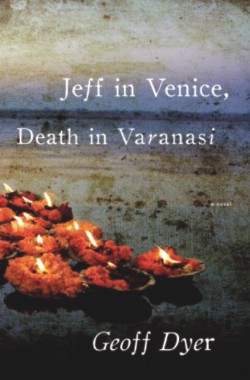|
Book Review
Jeff in Venice, Death in Varanasi
Terry Hong
 Geoff Dyer's latest novel, teasingly titled "Jeff in Venice, Death in Varanasi," is quite the mind game. To play, you obviously have to read the book. Geoff Dyer's latest novel, teasingly titled "Jeff in Venice, Death in Varanasi," is quite the mind game. To play, you obviously have to read the book.
Here's the initial setup: two distinct parts with a few overlapping similarities. In the first, "Jeff in Venice," London journalist Jeff Atman is sent to the Venice Biennial to chase down an elusive subject for an article. Amid the booze and drug-filled parties (with a few forays into checking out a bit of art), he meets the attractive Laura and has the time of his life. In the second, "Death in Varanasi," an unnamed London journalist (also Jeff, we would assume) is sent to Varanasi as a last-minute replacement to write a travel piece. He is initially overwhelmed upon arrival in the holiest of India's holy cities, home to the ultimate in Hindu cremations along the Ganges River. He makes friends, files his article and decides to stay.
So once the final page is finished, the reader is left with two different stories, nominally related by a single character. While one is a hedonistic, status-seeking idyll of near-debauchery told in the third person, the other is a first-person narrative about paring down and letting go. Both are interesting enough stories, detailed and engaging, and certainly the reader could leave it as one man's life journey from one extreme to another.
But why stop there? And are the stories so different? Yes, both Venice and Varanasi are legendary waterlogged cities with ubiquitous boats ferrying travellers, and awash in stifling heat as a journalist chases down a story. But look deeper, and the two seemingly distinct parts begin to flow in and out of each other.
Laura tells Jeff at their second meeting that she'll soon be leaving her Los Angeles gallery job (a job that also allows her to collect art) to be a hedge fund manager in - of all places! - Varanasi! Although Laura vanishes after Venice, another banker-cum-art-collector takes her place to tell unnamed-Jeff about the Ganges View, a well-kept hotel secret in the heart of the holy city.
In Venice, Jeff refers to the endlessly shallow chats notorious at alcohol-driven gatherings as "conversational pyre"; in Varanasi, the unnamed-Jeff, too, will be surrounded by very different pyres: the cremation sites that mark the holy ghats. When Jeff and Laura fall into bed for the first time, he discovers her well-placed dolphin tattoo and seeks the joys of seeing it often; the unnamed-Jeff will continue that search for mythical dolphins in the Ganges. Laura jokes that Jeff looks "like a monkey" as he eats a banana strolling through Venice; fellow Varanasi visitor Laline will repeat the exact same words to the unnamed-Jeff when he eats only bananas while recovering from stomach distress.
Once he parts from Laura in Venice, Jeff visits a church - where he snorts a final line of coke - and equates his exit to "getting resurrected." While he strips off his drenched shirt and contemplates walking into the polluted canal, he repeats to himself the joke he shared with his missing lover, "the eat was otter than ever." The unnamed-all-alone Jeff in Varanasi has stripped down to merely a dhoti (a traditional male loincloth-like wrapping), contemplating the various lives he is not living (a 1950s war criminal in Buenos Aires, or at home watching a Varanasi documentary). At river's edge (where he now bathes every morning oblivious to its teeming filth), he chants "Ganoona," the name of a new kangaroo god he has added to the Hindu pantheon, convinced Ganoona is "more otter than kangaroo."
One story begins with " 'I just can't do this s- any more,' " and ends in a stripped-down resurrection of sorts after visiting a holy site. The other begins bewildered in a holy city, the gateway to the next life, and ends with "Anything seemed possible." So here's the final question: As absurd as this may sound, could the two stories be mere variations of each other with a scrambling of key details? Water, boats, heat, new friends from California, and dolphins, monkeys, otters, oh my. Indeed, in Dyer's enigmatic novel, every reader will have to discover his or her own answers.
This review first appeared in The San Francisco Chronicle.
Copyright
(R) thedailystar.net 2009 |
